Pincha Mayurasana Explained: Forearm Balance in Iyengar Yoga
Pincha Mayurasana — known as Forearm Balance or Feathered Peacock Pose — is one of the most rewarding and technically demanding inversions in yoga. Practiced in the Iyengar method, it emphasizes precise alignment and shoulder lift to create stability and lightness while balancing upside down on the forearms. It builds strength and stability through the upper body, teaches precision in shoulder alignment, and challenges your capacity for focus and control. But more than anything, Pincha Mayurasana is a pose that requires understanding — of how to prepare, how to support, and how to lift.
This article is based on a free full-length Yoga Selection video tutorial, which you’ll find embedded below. The step-by-step sequence that follows is drawn directly from that class and presents a clear, progressive pathway through foundational preparations, supported variations, and advanced refinements — all rooted in the alignment-based principles of Iyengar Yoga.
Whether you’re just beginning to explore forearm balance or working toward free-balancing in the centre of the room, this tutorial is designed to deepen your understanding of Pincha Mayurasana. Along the way, you’ll develop the physical and mental tools needed to support the pose with clarity and confidence.
Through the process, you’ll also:
- Improve shoulder mobility
- Build upper body strength
- Cultivate balance, focus, and body awareness in inversion work
Use the breakdown below to follow along with the class, revisit key actions, and progress at your own pace.
Table of Contents
- Free Class Video
- 9-Pose Grid Overview
- Preparation 1 – Hands on Wall
- Preparation 2 – Elbows on Chair
- Preparation 3 – Walking Feet In
- Preparation 4 – With Shoulder Support
- Preparation 5 – Palms Turned Up
- Preparation 6 – Stepping up Wall
- Full Pose with Wall Support
- Full Pose with Elbow Elevation
- Free Balance – Final Variation
- Refining and Deepening Your Forearm Balance
Free Class Video
Follow along with this full-length Iyengar Yoga class as you explore step-by-step variations that build toward Pincha Mayurasana. The sequence breaks down key techniques, helping you develop strength, mobility, and confidence in this challenging inversion.
Last updated: July 20, 2025 — This article has been fully revised with updated visuals, pose breakdowns, and a new free instructional video.
9-Pose Grid Overview
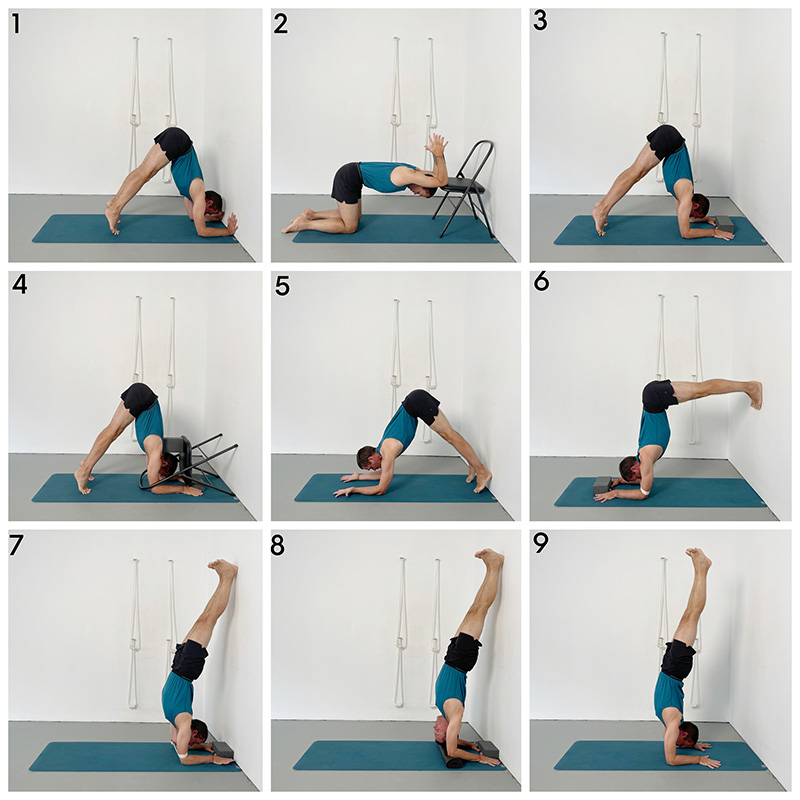
This image grid offers a snapshot of the nine key stages in the Pincha Mayurasana sequence. Scroll down to explore each pose in more detail.
Preparation 1 – Hands on Wall
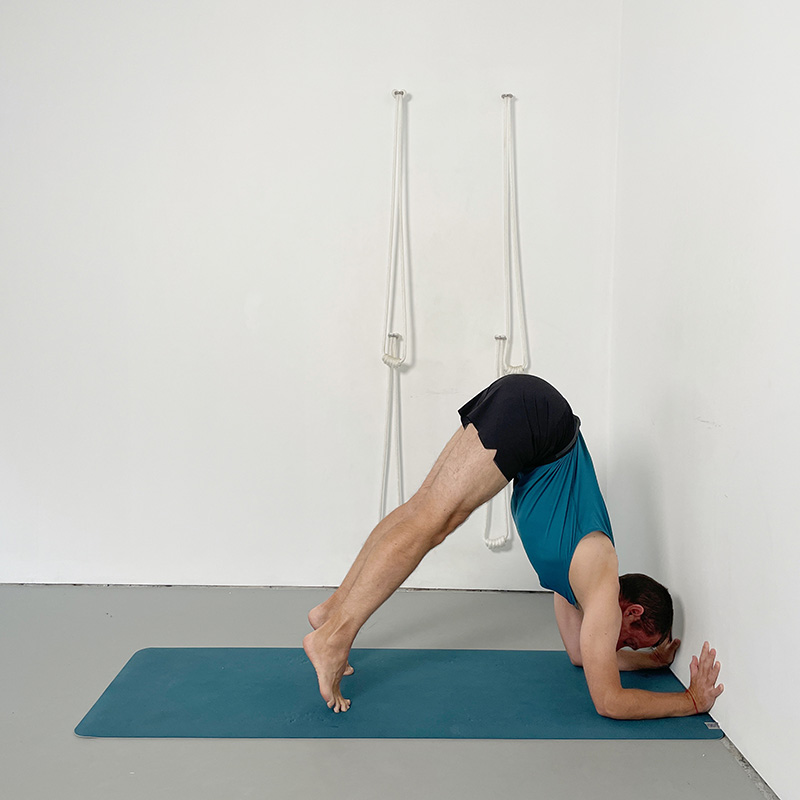
This Pincha Mayurasana preparatory variation introduces foundational concepts that are crucial for practicing Forearm Balance safely and effectively. It teaches three essential elements that will be revisited and deepened in the following stages:
- Lifting through the shoulders,
- Pressing the inner (thumb-side) wrists down, and
- Preventing the elbows from splaying outward.
By combining these actions, the pose strengthens and mobilises the upper body while revealing any tightness or limitations in the shoulders. It also develops the muscular coordination necessary to support the body in an inversion. Positioned early in the sequence, this variation acts as a diagnostic and preparatory pose — giving you a chance to organise key alignment principles before transitioning to more weight-bearing or inverted work.
Key Actions and Teaching Points
- Start in a kneeling position facing the wall, placing your hands on the wall and sliding them down until your palms reach the floor.
- Ensure your wrists are shoulder-width apart and your fingers, including the thumbs, are consciously spreading and fanning apart.
- Press the inner wrists (thumb side) firmly into the floor — this is often a challenging area to ground fully.
- While maintaining that inner wrist pressure, draw the elbows slightly inward toward the centre line — this creates containment without collapsing the elbows outward.
- Feel how the upper arms lean back slightly into the body, creating lift through the shoulders and the area between the collarbones.
- Tuck the toes under and straighten the legs, walking the feet in toward the elbows while keeping the shoulders lifted and the pelvis drawing upward.
Preparation 2 – Elbows on Chair
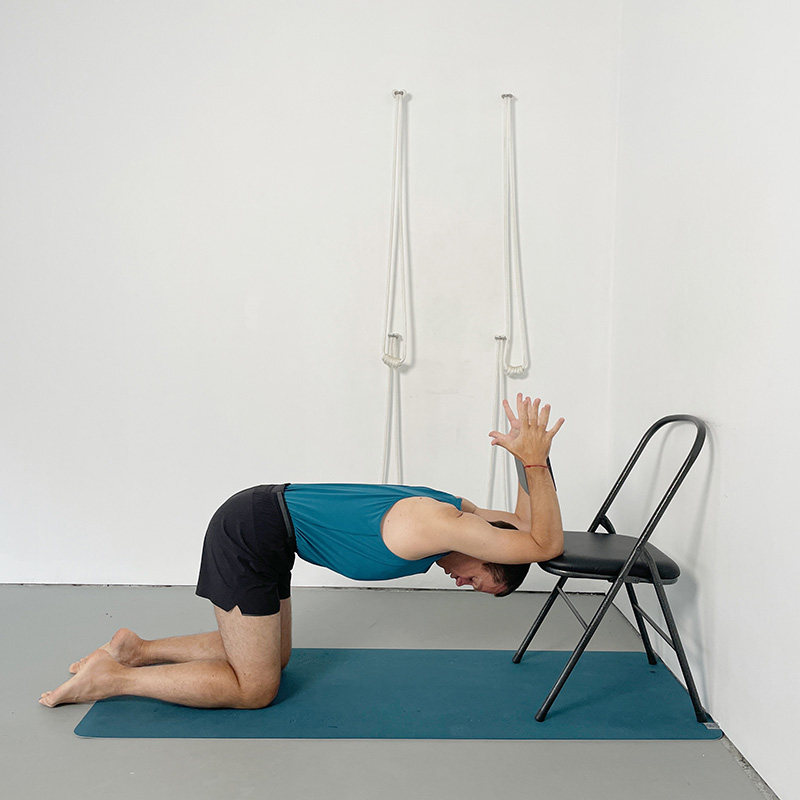
In preparing for Pincha Mayurasana, it’s important to strike a balance between poses that build strength and those that improve mobility. This variation — using a chair and a yoga block — is highly effective for developing the shoulder flexibility required to align and support the full inversion.
If shoulder mobility is lacking, rushing into the final pose often results in the shoulders collapsing forward or outward. Not only does this compromise the integrity of the shoulder joints, it can also lead to compression in the lower back. Proper shoulder flexibility allows the upper body to align in a way that supports the pose through skeletal structure, rather than relying entirely on muscular effort. Without this alignment, sustaining the pose becomes significantly more difficult and less stable.
This supported variation highlights that mobility aspect clearly and safely. Practised regularly, it can help unlock the range of motion needed to fully access the key alignment and weight-bearing mechanics of Pincha Mayurasana.
Key Actions and Teaching Points
- Position a chair near the wall and place the front legs of the chair on your yoga mat to prevent sliding.
- Grip a yoga block between your hands and inner wrists: half in the palms, half in the wrist creases. You may need to flare your fingers outward initially to make wrist contact, then straighten them once stable.
- Lower your elbows onto the seat of the chair, keeping the knees beneath or just behind the hips. Let your head release down between your arms — either resting on the chair or hanging freely.
- Adjust the knee position to modify the intensity: knees further back deepen the shoulder work; knees closer to the chair ease it.
- Actively spread your fingers and squeeze the block with the inner wrists to reinforce forearm containment and upper arm engagement.
- Allow the upper arms to release downward, while simultaneously lengthening from the elbows to the pubic bone and back pelvis, ensuring that the lower back stays long and supported throughout.
Preparation 3 – Walking Feet In

This variation introduces the classical arm positioning of Pincha Mayurasana: forearms parallel on the floor, palms pressing down, and fingers actively spreading. A yoga block is placed between the hands to help prevent them from sliding inward once weight is transferred into the arms — a common tendency in early stages of learning the pose.
Although the legs remain grounded, this variation teaches several core elements of the full inversion, particularly the ability to lift through the shoulders while weight-bearing on the forearms. It’s a valuable checkpoint in the sequence — one where you can explore shoulder engagement, wrist action, and elbow containment in the correct structural arrangement, without yet needing to balance upside down.
Practising this variation regularly helps develop both the strength and control needed for more advanced stages of the pose. It also shines a light on how challenging it can be to maintain shoulder lift — especially as the hips begin to rise and the pose becomes more vertically oriented.
Key Actions and Teaching Points
- Begin on hands and knees. Place a block flat to the floor, then position your forearms parallel on the floor, shoulder-width apart.
- Grip the block lightly with your thumbs pressing into its sides, and position the index finger knuckles near the block but not jammed against it.
- Spread the fingers and press the thumb side of each wrist into the floor, resisting the common tendency for the inner wrists to lift.
- Draw the elbows gently inward toward the midline without allowing them to collapse or widen — this helps maintain structural containment.
- Tuck the toes under and straighten the legs, lifting the hips and walking the feet toward the elbows while keeping the shoulders lifted.
- Focus on sustaining upward lift through the collarbones and side ribs, despite the increasing weight transferred into the arms.
Preparation 4 – With Shoulder Support
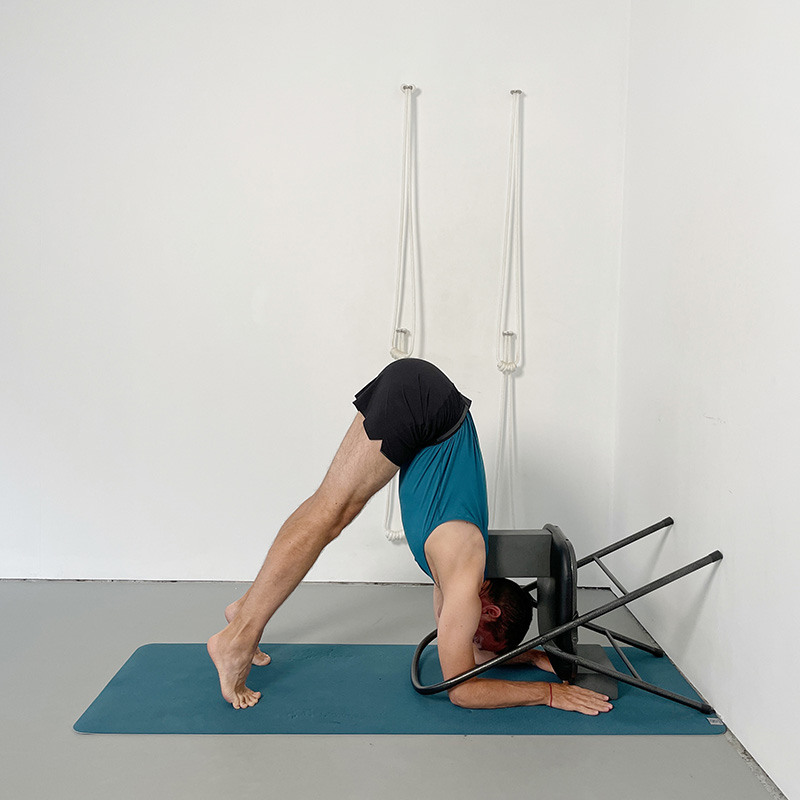
Having established in the previous variation how challenging it can be to maintain shoulder lift when approaching the inverted position, this variation provides support to actively assist that lift. A yoga chair is placed on its back, and a block is wedged between the seat and your upper back — just below the base of the neck. This prop setup allows you to experience what it feels like to maintain shoulder elevation without relying solely on muscular strength.
With the block supporting the upper back, even practitioners with limited upper body strength will be able to lift the pelvis higher and walk the feet in closer to the elbows. As the pelvis begins to stack more directly over the shoulders, the sensation of true inversion becomes more accessible — all while preserving alignment and reducing the risk of collapsing into the shoulders or lower back.
This variation helps to bridge the gap between grounded preparations and full inversions by making the internal lift of the pose clearer, safer, and more achievable.
Key Actions and Teaching Points
- Set the yoga chair on its back, with the feet braced against the wall. Place a folded blanket between the chair and the wall if needed to protect the surface.
- Position a block between the seat of the chair and your thoracic spine – it should press into the upper back just below the neck, not directly into the cervical spine
- Straighten your legs and walk your feet in, pressing your upper back into the block. Once stable, release the hands and place them flat on the floor in forearm position.
- Use the block’s resistance to generate lift through the shoulders, collarbones, and side ribs – and throughout the upper body.
- Keep the inner wrists pressing down, the elbows contained, and the eyes focused between the forearms.

Join Yoga Selection Today
Unlock full access to Yoga Selection’s complete video library, featuring expertly taught Iyengar Yoga classes and structured learning paths.
Start Free TrialFull access. Cancel anytime.
Preparation 5 – Palms Turned Up
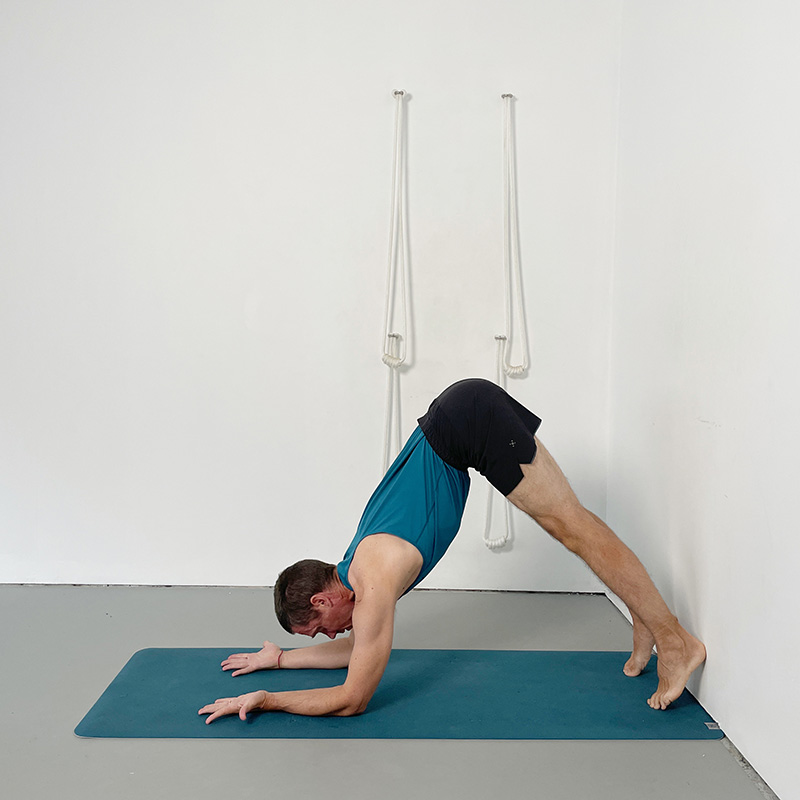
This variation focuses on a key action that forms the foundation for shoulder lift in Pincha Mayurasana: the outward rotation of the upper arms. By deliberately turning the biceps away from one another, the shoulders gain a subtle but essential upward direction, preventing collapse and creating space across the collarbones.
To highlight this action, the forearms are rotated so that the palms face upward and the thumbs point outward, which strongly emphasises the external rotation of the upper arms. Once experienced in this more corrective setup, the same action can later be applied more subtly — but just as effectively — when the arms return to their classical positioning with palms down.
This variation sharpens your proprioceptive awareness and deepens your understanding of how to create lift without relying solely on brute strength.
Key Actions and Teaching Points
- Begin in a kneeling position with your forearms shoulder-width apart and your palms turned upward, thumbs pointing outward.
- This orientation helps highlight the external rotation of the biceps, drawing the upper arm bones slightly back and encouraging lift through the shoulders.
- Press the thumb side of each wrist down into the floor, especially as the thumbs may initially struggle to stay grounded.
- Focus on the rotational action in the upper arms, not the wrists or hands — the goal is to train the shoulders to respond to that bicep rotation.
- Tuck the toes under and straighten the legs, lifting the pelvis and walking the feet in while keeping the shoulders lifted and elbows contained.
- Once familiar with this action, return to the classical arm position (palms down) and retain the memory of that outward rotation to maintain shoulder lift in later variations.
Preparation 6 – Stepping Up Wall
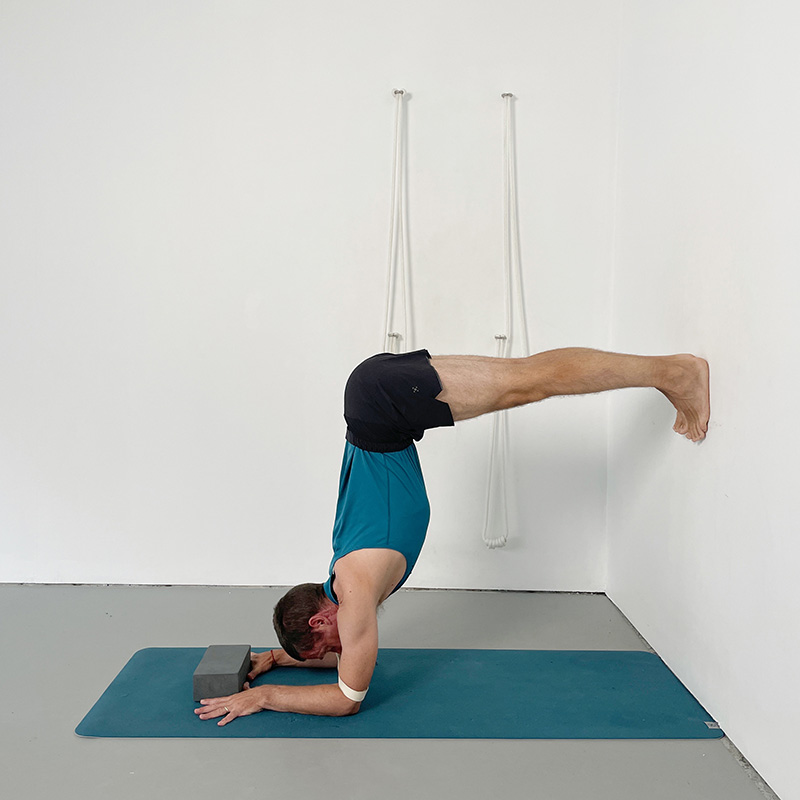
Having established variations that teach essential techniques, build strength, and improve shoulder mobility, this stage introduces the inverted aspect of Pincha Mayurasana. Rather than kicking up, you step one foot at a time up the wall, gradually shifting into a vertical orientation while maintaining control and structure in the pose.
This version allows you to bear more body weight through your forearms, providing a direct experience of inversion without the added complexity of balancing. A belt is placed around the elbows to prevent them from splaying under pressure — an essential support as you adapt to the load of full inversion.
All of the key actions from the previous stages must now be synthesized and maintained under full weight: shoulder lift, forearm grounding, biceps rotation, and pelvic alignment. This is the final preparatory stage before moving into the full version of the pose using a dynamic kick-up.
Key Actions and Teaching Points
- Measure a leg’s length distance from the wall, then place your forearms shoulder-width apart and fasten a belt snugly around your elbows.
- Spread the fingers and press the inner wrists into the floor, keeping the arms parallel and contained within the belt loop.
- Briefly rotate the palms upward to reconnect with the action of biceps rotation, then return them to the floor while retaining that internal lift.
- Straighten the legs and walk the feet toward the wall, then step both feet up, bringing the body into a vertical shape supported by the wall.
- Maintain upward lift through the shoulders, collarbones, side ribs, and pelvis, and avoid collapsing into the elbows or lower back.
- Focus your gaze toward the mat between the forearms, keeping the head neutral and the body integrated from base to heels.
Full Pose – With Wall Support
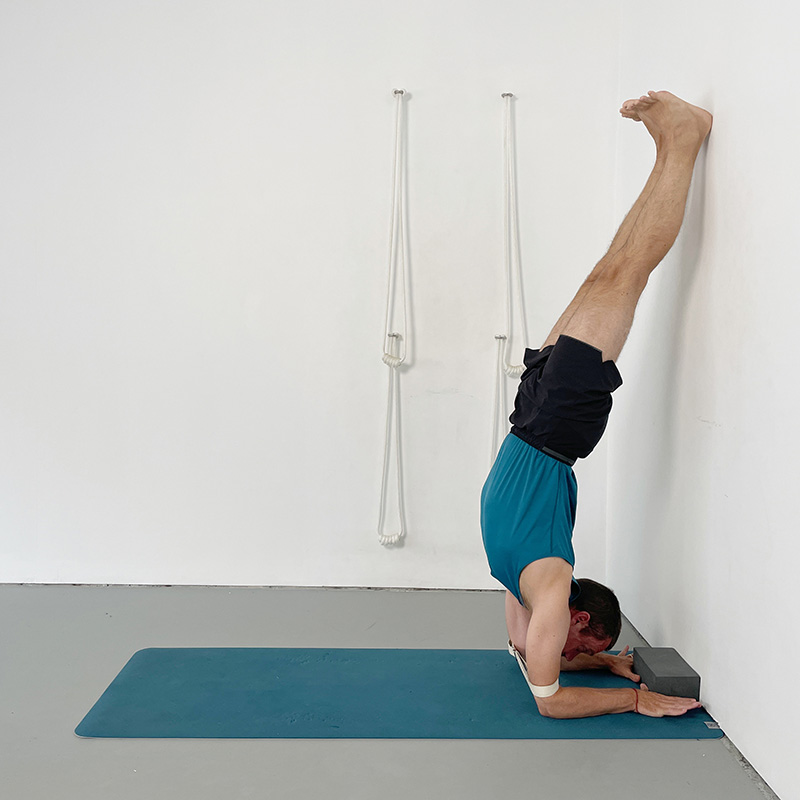
Having progressed through the preparatory stages, you are now ready to experience the full inverted shape of Pincha Mayurasana. In this variation, you kick both feet up to the wall and begin to consolidate the foundational actions under full weight and vertical alignment.
As in the previous variation, a belt is placed around the elbows to prevent splaying. A yoga block is also positioned at the wall, not simply as a passive spacer, but as something to actively press into with your thumbs. This action supports shoulder lift and reinforces forearm engagement.
Now that shoulder alignment has been established, this stage introduces another key refinement: preventing compression in the lower back. The focus shifts toward lifting the back of the pelvis and drawing the front ribs inward and upward, helping to extend and stabilise the spine while inverted.
This is a stage where many practitioners will spend time consolidating, refining their alignment, and building the strength and awareness necessary for balance-based work in the pose.
Key Actions and Teaching Points
- Place a belt around your elbows, adjusted to shoulder-width, and position a block vertically at the wall, between your hands.
- Set your hands so the thumbs press firmly into the block, while keeping the inner wrists grounded and the forearms parallel.
- Kick both feet up to the wall, then check your alignment: the shoulders should remain lifted, not collapsing toward the elbows or ribs.
- Maintain elbow containment using both the belt and muscular action — avoid relying passively on the belt alone.
- Press the thumbs into the block to assist shoulder lift, and draw the back of the pelvis upward to prevent lumbar compression.
- Bring the front ribs in and up, lengthening the spine from forearms to heels, and hold the gaze steady between the forearms.
Full Pose – With Elbow Elevation
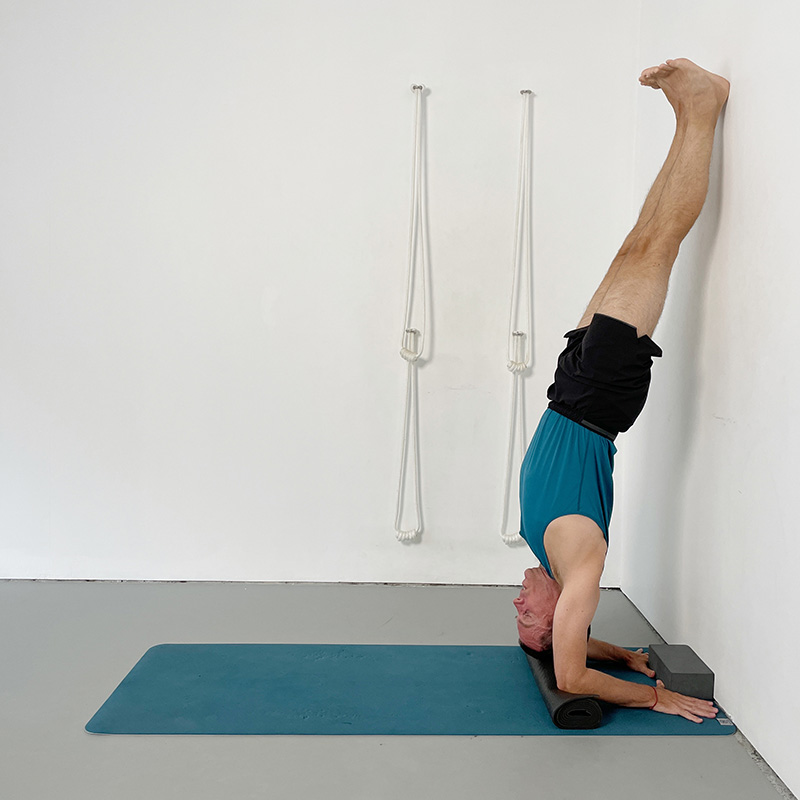
Placing a rolled mat or blanket under the elbows can have a powerful corrective effect in Pincha Mayurasana. Elevating the base of the pose helps to counteract the common tendency to collapse into the shoulders, chest, or lower back, especially once inverted. This type of collapse is often unintentionally reinforced when the gaze drops too early toward the floor between the forearms.
With the elbows elevated, there’s greater space and support to initially position the head to look forward, toward the centre of the room. This orientation helps to lift the spine and pelvis more effectively, allowing the forearms to press into the mat and create vertical energy through the entire body.
Once lift has been established — through the shoulders, front ribs, back of the pelvis, and legs — the head can then return to the classical position, with the eyes gazing down, but the structure of the pose remaining buoyant and lifted.
This variation is best viewed as an occasional corrective, rather than a prop-dependent setup. It’s particularly helpful for experienced practitioners who regularly practise Pincha Mayurasana and want to reset alignment and prevent ingrained habits of collapse.
Key Actions and Teaching Points
- Place a rolled yoga mat or blanket just far enough from the wall so that your elbows rest securely on it when your hands are positioned near a vertical block.
- Use a belt around the elbows if containment feels unstable with the added elevation, especially on first attempts.
- Kick up to the wall, and instead of looking straight down, let your gaze turn forward toward the centre of the room — similar to headstand orientation.
- Use the leverage of the forearms pressing down to lift the front ribs, back of the pelvis, and legs upward while keeping the back ribs integrated.
- Once you’ve created this energetic lift, return the gaze to the floor while maintaining the upward direction through the entire body.
- Practise this variation occasionally to correct habitual collapse and restore vertical clarity in the pose.
Free Balance – Final Variation
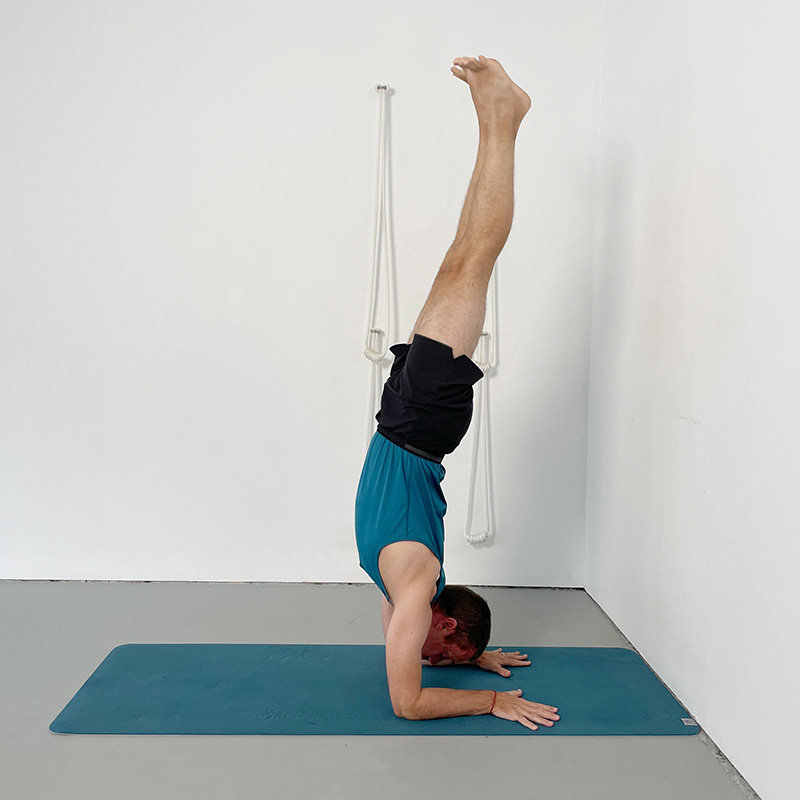
Once each of the previous stages has been learned and consolidated, there is a natural progression toward the unassisted, freestanding version of Pincha Mayurasana — balancing in the full pose without the support of the wall, belt, or props.
This stage demands not only refined shoulder lift and stability through the forearms, but also precise control of the head and pelvis, which must remain steady for balance to be achieved. It adds the challenge of equilibrium to the technical foundation already established, requiring both physical integration and mental focus.
While balance becomes the new variable, the core actions of shoulder lift, elbow containment, spinal length, and pelvic alignment remain exactly the same. This variation brings together all of the work developed across the previous stages — now unified in a single, cohesive expression of the pose.
Key Actions and Teaching Points
- Begin in your forearm balance setup, positioned slightly away from the wall. Use a belt if needed, but remove any blocks or support props.
- Kick up toward the pose, but instead of relying on the wall, initiate your balance before the feet make contact — using the feet only as a reference point.
- Keep the gaze steady between the forearms, and focus on stabilising the head and pelvis. These two points must remain steady as the legs begin to move.
- As one foot leaves the wall, allow the second leg to follow, bringing the feet together overhead while keeping the upper body unmoving.
- Maintain upward lift through the collarbones, side ribs, and pelvis, and resist the tendency for the weight to drop into the elbows or lower back.
- Use this variation not just to balance, but to consolidate and refine the entire pose, now practiced in its freestanding form.
Refining and Deepening Your Forearm Balance
Pincha Mayurasana rewards consistent, thoughtful practice. Return to the free video and these nine variations often—each round will sharpen shoulder-lift, refine pelvic alignment, and build the calm focus that lets the pose feel buoyant rather than forced. As your balance steadies, keep revisiting the preparatory stages: they remain the fastest way to correct habits and maintain a healthy shoulder-to-spine relationship.
When you’re ready to go further, explore the full 2-part Pincha Mayurasana Course inside Yoga Selection. There you’ll find longer practices, troubleshooting sequences, and progressive routines that integrate forearm balance into back-bends, arm balances, and flow work—helping you embed the pose into every corner of your practice.

Join Yoga Selection Today
Unlock full access to Yoga Selection’s complete video library, featuring expertly taught Iyengar Yoga classes and structured learning paths.
Start Free TrialFull access. Cancel anytime.
Explore Specialised Yoga Courses at Yoga Selection
The pincha mayurasana classes and courses discussed in this article can be found on yogaselection.com. Yoga Selection is a comprehensive online platform offering a wide range of yoga classes, courses and resources, including specialised courses targeting specific asanas.
As a Yoga Selection member, you gain unlimited access to our extensive video library, featuring over 900 on-demand classes. Additionally, explore a diverse range of courses, with two new videos released every week.
Experience the flexibility of joining live classes in real time, allowing for personalised guidance and support. Immerse yourself in a vibrant community that nurtures your growth and provides valuable resources for your yoga practice.
About Rod Stennard
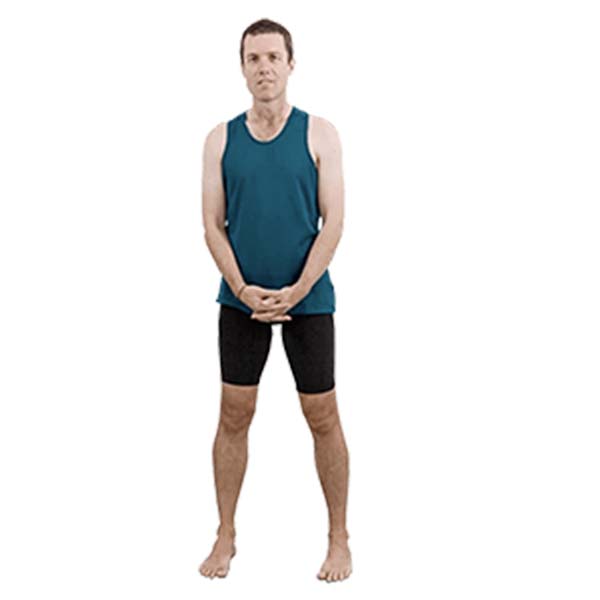
Rod Stennard – Founder of Yoga Selection
Rod Stennard is the founder of Yoga Selection, the first online yoga platform dedicated entirely to Iyengar Yoga. A certified Iyengar Yoga teacher since 2002, Rod has practiced yoga since 1992 and studied under senior teachers from around the world, including members of the Iyengar family in Pune, India.
Rod launched Yoga Selection in 2016 to bring structured, high-quality Iyengar Yoga training to a global audience. As a pioneer in the field of online yoga education, he is passionate about making this method accessible to all, through rigorous, inclusive, and thoughtfully designed classes. His work continues to support students of all levels in over 50 countries.
See related posts:
Share:
